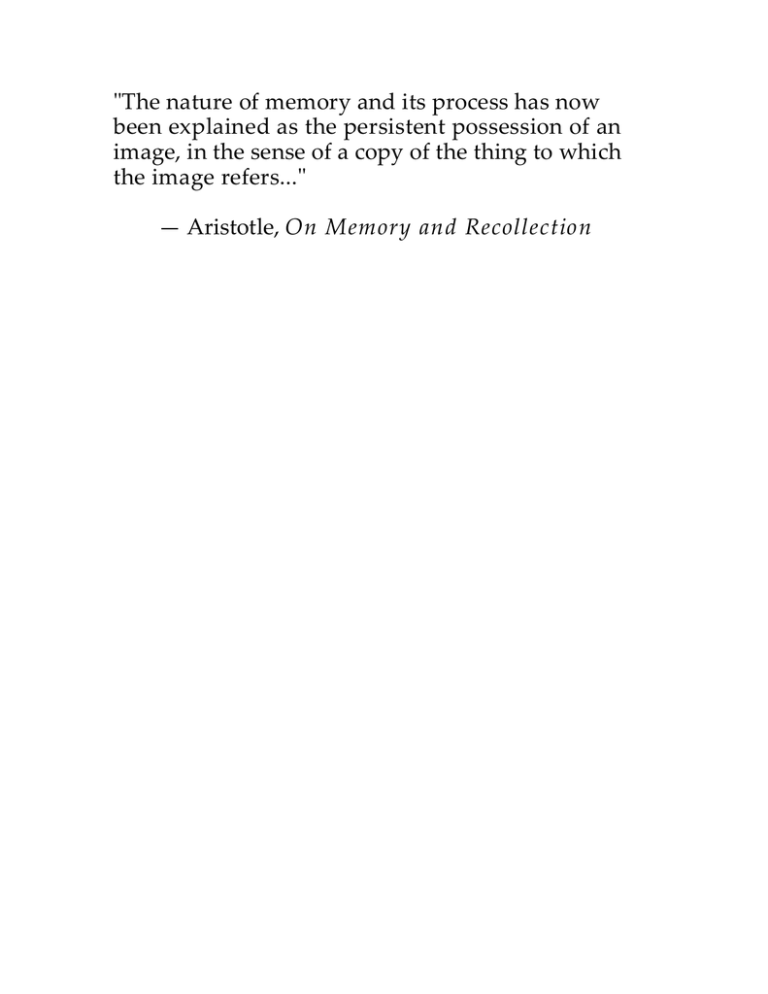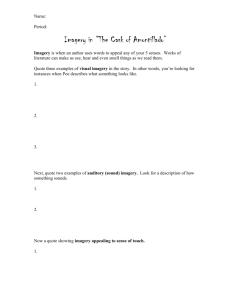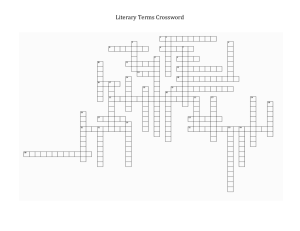"The nature of memory and its process has now
advertisement

"The nature of memory and its process has now been explained as the persistent possession of an image, in the sense of a copy of the thing to which the image refers..." — Aristotle, On Memory and Recollection "... after the object is removed or the eye shut, we still retain an image of the thing seen, though more obscure than when we see it." — Thomas Hobbes, Leviathan "... The ideas of the nurse and mother are well framed in their [children's] minds; and, like pictures of them, represent only those individuals." — Locke, Essay Concerning Human Understanding Hamlet: My father... Methinks I see my father. Horatio: Where, my lord? Hamlet: In my mind's eye, Horatio. — Shakespeare, Hamlet, Act I Problems with the "Image-As-Picture" Notion • Indistinct details: the "tiger" example • Difficulty of reinterpretation: the "ambiguous figure" example • Difficulty of re-examination: the "Star of David" example • The homunculus objection What is Imagery? A Collection of Experiments • Mental Rotation • Mental Scanning • Interference with Visual Imagery • Reproduction of Some Types of Visual Effects • "Imagery Overflow" Experiments • "Imagery Grain" Experiments What is Imagery? A Collection of Experiments • Mental Rotation Shepard and Metzler blocks rotation experiment • Mental Scanning Kosslyn et al. Island experiment Finke and Pinker "arrow-pointing" experiment • Interference with Visual Imagery Brooks "follow-the-star" experiment • Reproduction of Some Types of Visual Effects Ponzo Illusion McCollough effect (Finke and Schmidt) Spatial Resolution (Finke) • "Imagery Overflow" Experiments Kosslyn "walk-toward-the-ruler" experiment • "Imagery Grain" Experiments Kosslyn "rabbit-whisker" experiment Experiments in Mental Imagery: A Summary • Certain types of operations may be performed on mental images Rotation (Shepard and Metzler) Scanning (Kosslyn, Ball, and Reiser) • Visual/Spatial Cognition Interferes with mental imagery "Moving-Star" experiment (Brooks) • Mental Imagery seems to recreate some visual effects... McCullough effect (orientation-specific color aftereffects) Resolution (Finke's experiments on stripe patterns) Ponzo illusion (Wallace) • ... But not others Ambiguous figures (Chambers and Reisberg) Finding "parts" of figures (Reed) Sources of Controversy: Arguments Against a Straightforward Model of Mental Imagery • Introspection is an insufficient guide • "Hidden" Knowledge (e.g., direction to scan) • Background knowledge (Pylyshyn's "cognitive impenetrability") • The "parsimony" argument • Mental imagery seems to do too much • Mental imagery doesn't do enough (Hinton's example) Kosslyn's Model of Mental Imagery • Neurological Evidence PET Results Studies of Brain-Lesioned Patients • What this model might explain Weak or fleeting nature of imagery Need for transformations (e.g., rotation) Interference with other visual effects Open Questions • Relation between 2D and 3D imagery • Relation between visual imagery and other types of sensory input (especially tactile) • Static vs. Dynamic Imagery • Role of mental imagery in other representations (prototypes, scripts) Trainability/Development (Imagery as a Skill) • Visualizing Polyhedra: Using Propositional Knowledge to Guide Imagery • The need for better models (the agenda for AI)




